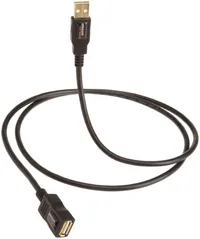USB Wi-Fi Adapter 101
Extension Cable
A USB Wi-Fi adapter will only work as well as the signal it receives from the router. With the metal cases that surround most desktops, and the myriad of wires that supply power and data between the devices of a typical desktop, it is quite common for the available USB port that will accommodate the adapter to not be in an optimal location for maximizing signal strength. Add in the additional interference from nearby Wi-Fi networks and, in situations where the router is not in the same room as the computer, some signal strength optimization is often required.
Thankfully, there is a simple fix for this. A short (24” often works well) USB extension cable can allow a rear USB port to be utilized for the Wi-Fi adapter, while allowing the adapter to be positioned far enough away from the case, and in the direction of the router to gain signal strength. Such cables are available inexpensively, and can be indispensable to optimize the location of the antenna in relation to the router.
Get Tom's Hardware's best news and in-depth reviews, straight to your inbox.

Jonas P. DeMuro is a freelance reviewer covering wireless networking hardware.
-
Achoo22 Replya computer needs to be connected to its network, and in turn the Internet, to be truly useful
I got this far, then tuned out. -
SuperVeloce Reply
okay, I see you don't get what the intended audience in this article is. i'll re-word that for you: "a multimedia family / office work computer needs to be connected to its network..."a computer needs to be connected to its network, and in turn the Internet, to be truly useful
I got this far, then tuned out. -
SamSerious USB extension cables are often causing problems. I'd never extend a cable by more than one meter and make sure it is a very high quality cable or the voltage will lower dramatically causing the device not to work properly anymore. Or you have to get yourself an active USB expander which is usually quite a bit more expensiv.Reply
On the other hand, antenna cables are even worse to extend... -
jacobian You think you need USB3 to drive a 802.11ac network adapter at full speed? Please. You couldn't have been more confused. Let's say we're talking about a two stream AC device, so theoretically it's capable of 867mbps throughput in 5GHz band. However, much of that number pertains to the "physical layer" information transfer, the chatter that ensures that your data is transferred accurately, under optimal condition (e.g. 6 ft from the router). At TCP/IP level, the throughput will be much lower, even if the distance is short, somewhere in the neighborhood of 100-300mbps, depending on your luck. In other words, a lot less than USB2 can handle.Reply
You see, the wireless data transfer rates are basically a big marketing scam because half of more of that data transfer rate will disappear due to weakening signal with distance or on the physical layer chatter. Wireless is not like wired Ethernet, where saying 100Mbps really means that you will actually see TCP/IP data transferred nearly at that rate. In the wi-fi world, the marketing can say they sell you a "gigabit ac1750 router (or adapter)", and in real life you may well end up with just 100Mbps or slower data throughput. If you get 200mbps or more, you should be jumping from joy. -
ZeusGamer I'm using a dual band PCI Express wi-fi module. For some reason, it's much better than my ethernet connection. Could be because my killer port is only single band rather than dual. I've not lagged one bit with this accessory and I've been using it for at least 8 - 9 months now.Reply -
user_friendly Id like to point out that having an external usb wifi can get really hot and malfunction. Its not inside of an air circulated case, so mine tends to get blazingly hot. i have the n600 which i can game on and have no problems. MosltyReply
